Mixpanel for Product Analytics: Features, Pricing, and Review

Looking for an effective product analytics tool and wondering if Mixpanel is the best option for your SaaS company?
With numerous Mixpanel alternatives, it can be challenging to make a final decision.
In this article, we’ll delve into precisely that – helping you determine whether Mixpanel is the ideal choice for your product analytics needs. We’ll explore its features, pricing, and offer a comprehensive review to aid in your decision-making process.
Let’s get started!
TL;DR
- Mixpanel is a good choice for product analytics and it comes with features such as feature tags, funnels, paths, and in-app events.
- Let’s look at the most common scenarios where Mixpanel is NOT the right tool for your user onboarding needs and you should be looking into using a different one:
- You need better customer support: Mixpanel has been criticized for its poor customer service. You can have a hard time getting the software problems fixed quickly since you might rarely get an instant response from the support team.
- You want behavior-driven product tours: you are seeking to guide users through their product’s features using behavior-driven triggers, a solution like Userpilot is more appropriate.
- You want advanced segmentation: You can create targeted user segments based on specific parameters such as pricing plans, company, location, required actions, NPS score, and more on Userpilot.
- If you’re looking for a better option for product analytics, Userpilot exceeds both functionality and value for money compared to Mixpanel.
- Ready to see Userpilot in action? Schedule a demo today to explore its powerful product analytics capabilities firsthand.
What is Mixpanel?
Mixpanel is a simple and powerful product analytics tool that allows product teams to track and analyze in-app product engagement. It allows your team to see every moment of the customer experience clearly, so you can make changes that work.
In addition, it lets you explore data freely without using SQL. Set up your metrics to measure growth and retention. Slice and dice data to uncover trends and see live updates on how people use your app.
Must have features of product analytics tools
Here are the features to consider while opting for a product analytics tool:
- Event tracking: Allowing you to capture both no-code and server-side event.
- Capture qualitative data (i.e. survey or session recordings).
- Analytics dashboards: Having different analytics dashboards to monitor user behavior with options to view and break down data in different ways.
- Segmentation: Sending product offerings, in-app messages, or trigger flows by segmenting users based on various attributes such as demographics, behaviors, product usage, user feedback, etc.
- Integration support: Can connect with other data sources through integrations or webhooks for a more well-rounded understanding.
Mixpanel features for product analytics
Product analytics is the art of collecting, analyzing, and leveraging data to optimize products, explore user behavior, and drive business growth.
It supports both mobile and web apps, and it’s an analytics tool of choice for product teams across the globe, regardless of the company size.
Mixpanel product analytics functionalities work based on:
- User segmentation: User segmentation is the bedrock of effective product analytics in Mixpanel. You can divide your user base into distinct groups based on attributes, behaviors, or properties and uncover meaningful trends and preferences among various user groups.
- Funnel analysis: Mixpanel’s funnel analysis feature allows you to create sequences of events that users should ideally complete. This helps you gain insights into where users drop off and where they progress.
- Retention analysis: With the retention analysis feature, you are able to track how often users return to your application after their initial interaction.
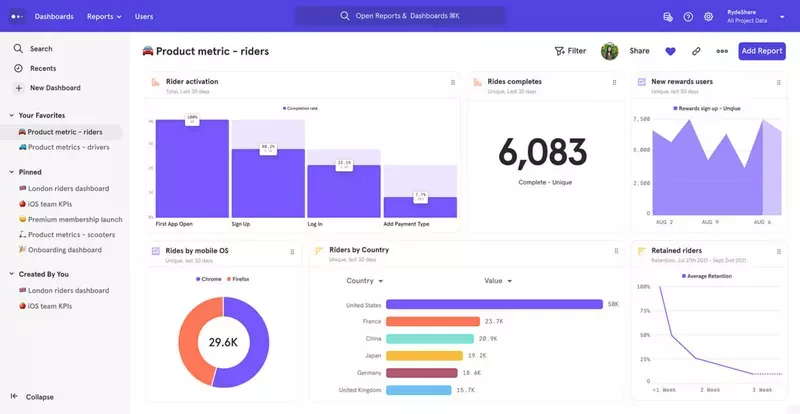
Mixpanel offers a free plan with very advanced product analytics functionality but no engagement layer or feedback features like that of Userpilot. Even though Userpilot may not support such advanced analytics as Mixpanel, it still offers enough to enable product managers to make data-driven decisions.
Mixpanel’s feature tags
Feature tags allow you to tag certain elements in your web app that you would like to track without interfering with your dev team.
However, in the case of Mixpanel, tagging a feature requires coding. As an analytics tool, Mixpanel provides two options for feature engagement tracking:
- Sending events from your servers by preparing a batch of events in JSON format and using the provided API endpoint (e.g., /import) to submit your batch.
- Or using one of Mixpanel’s client-side SDKs to track data via a third-party app or from your client devices.

Basically, without technical knowledge or a dedicated engineering team, you can’t start collecting feature engagement data right away. So you should take technical capabilities into account when deciding to integrate Mixpanel into your analytics workflow.
Mixpanel’s funnels
Conversion funnel analysis is the key for SaaS businesses to increase conversions and generate more revenue.
Mixpanel’s funnels make it easy to track user progress throughout the customer journey. It does not simply provide a cluster of data but instead breaks down a user’s journey into sequential steps that are easy to track and analyze.
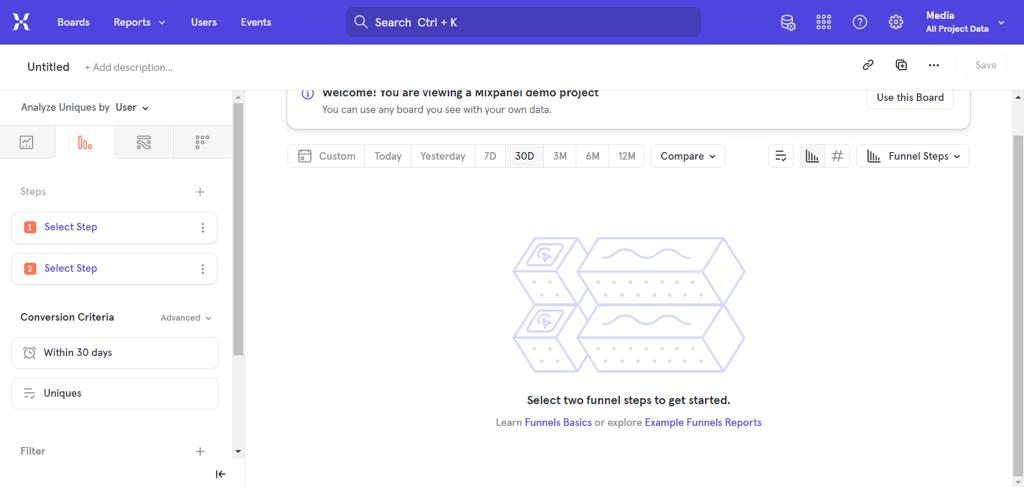
Here are features on MixPanel for tracking user funnels:
- Backfilling∫ Mixpanel’s default “backfilling” feature adds missing event properties. When a property appears in later funnel steps but not earlier ones, it is seamlessly integrated.
- Custom events: Mixpanel enables the creation of custom events by combining multiple events into one. This flexibility allows you to design funnels with multiple pathways leading to the same goal.
- Intuitive reporting: With Mixpanel, funnel reporting is user-friendly. The platform automatically generates graphs and charts as data flows in, providing instant visual insights.
Mixpanel has its own event tracking SDK, but it is much more limited in scope than Segment. It only tracks first-party data generated when customers use an app, website, or other digital channels.
Unlike Userpilot, you can’t analyze user paths up to 4 pages at a time at a glance on Mixpanel. In addition, Userpilot can track feature usage by user segments with heatmaps directly on the different pages of your product.
Mixpanel’s paths
Product managers use path analysis to determine how users navigate through websites and apps. It involves tracing the user’s path from any entry point and dissecting each step.
Below are the features available for path analysis on Mixpanel.
- Journey mapping: Choose where user journeys begin and end within a product or website. For example, track user actions post-app launch or video viewing. If the goal is a specific action, like completing a purchase, anchor the “end step” to uncover common paths leading to that outcome.
- Flow analysis: Identify and remove obstacles for a smoother customer journey.
Mixpanel works great for products with straightforward user paths and repeat-use features. But it’s less useful when your users’ journeys aren’t linear. Hotjar is a better alternative for nonlinear and more complex customer journeys.
Mixpanel’s in-app events
Mixpanel can track any event in less than 5 minutes. It can track sign-up events, value moment events, and so on. With this, you can understand your product’s growth by counting the number of sign-ups, and tracking a Value Moment event when a user reaches value in your product.
The only feature available for this is the custom event tracking feature.
However, you can track events through buttons by creating a button. How? With Userpilot. Once the user clicks on it, data is sent to Userpilot, indicating that the tracked event has occurred.
What are the pros and cons of Mixpanel?
Mixpanel’s pros
Let’s have a look at the pros of using Mixpanel:
- Sophisticated features that enable granular data analysis are a significant advantage of using Mixpanel because they allow you to gain deeper insights into user behavior, interactions, and trends. For example, with the event tracking feature, you can track user sign-ups, product purchases, clicks on specific buttons, and more.
- Unlimited segmentation capabilities: It offers unlimited segmentation capabilities on attributes, user properties, and cohorts. This level of segmentation gives you a more detailed view of your consumers and their engagement level.
- Easy-to-navigate UI patterns: The user interface of this platform is simple and has a wide variety of functions and resources to help you work in the most organized way, have better team coordination, and keep efficiency high.
- Seamless onboarding for your product team: Getting started on Mixpanel is easy and without stress. Register, choose a plan, or hop on for a free trial.
- A free plan that is sufficient for small SaaS companies: This free plan offers valuable features and resources — unlimited integrations, unlimited collaborators, templates, and essentials to get started quickly — that can help you gain insights into user behavior and make data-driven decisions, even when operating with limited budgets.
- Powerful interactive and easily accessible visuals: For quicker decision-making to beat analysis paralysis.
Mixpanel’s cons
While Mixpanel is a powerful product analytics tool with many great features, there are still some downsides. Here are the main cons of the tool:
- The free plan works well for small SaaS businesses, but enterprise-grade features can be expensive depending on your needs.
- You will need the help of your engineering team to set up and configure the tool — The platform’s advanced functionalities, custom event tracking and segmentation, might require a steeper learning curve, especially for those without a strong background in data analysis.
- Limited Attribution Models: While Mixpanel offers various analytics features, its attribution modeling capabilities might be more limited.
- There is no user feedback or engagement functionality, so you need third-party tools.
What do users say about Mixpanel?
Mixpanel is consistently termed an excellent, powerful, and result-oriented tool by its loyal customers. Generally, customers say it’s easy to use, easy to customize, and how easily it tracks analytics.
Here are the great stories customers are telling about Mixpanel:
These are some of the aspects that I appreciate about Mixpanel. It’s important to note that my preferences may vary depending on individual needs and requirements. I highlight some of the features and benefits that I appreciate about Mixpanel: Mixpanel focuses on individual user behavior and allows me to track and analyze user interactions at a granular level. This user-centric approach provides deeper insights into how users engage with my app and helps me understand their preferences and needs. This flexible platform allows me to tailor the analytics to my needs. I can define custom events and properties based on my app’s unique features and track the metrics that matter most to my business…
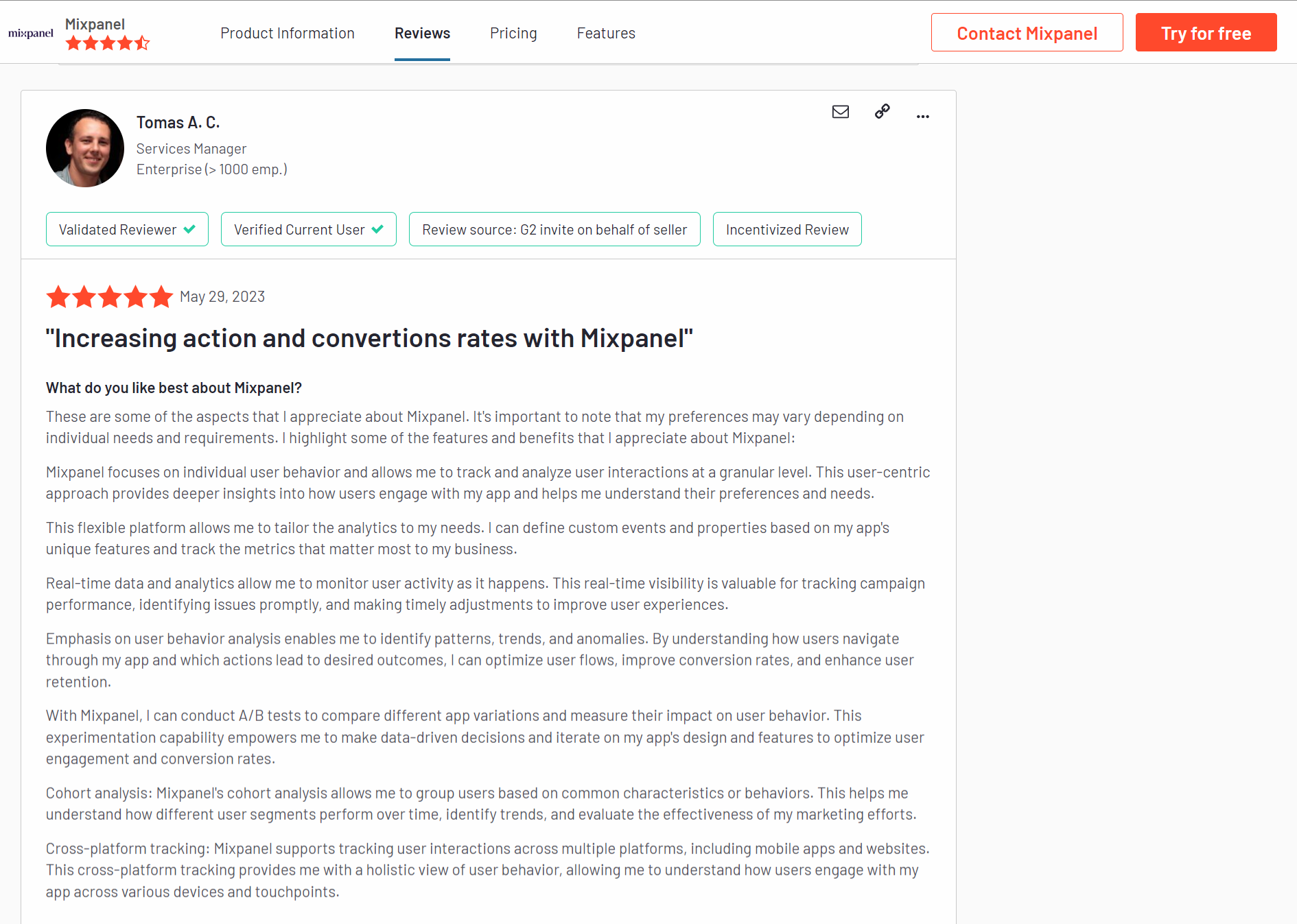 While Mixpanel has some great reviews, there are still some little downsides and quirks (same as every other SaaS tool). Here are some bad reviews of Mixpanel:
While Mixpanel has some great reviews, there are still some little downsides and quirks (same as every other SaaS tool). Here are some bad reviews of Mixpanel:
UI is not very intuitive and there is no live chat support to get quick answers so you have to break your workflow to figure things out. Also, I’m not sure if this is due to our data structure, but null values do not show in mixpanel, which greatly limits what can be done with the tool.
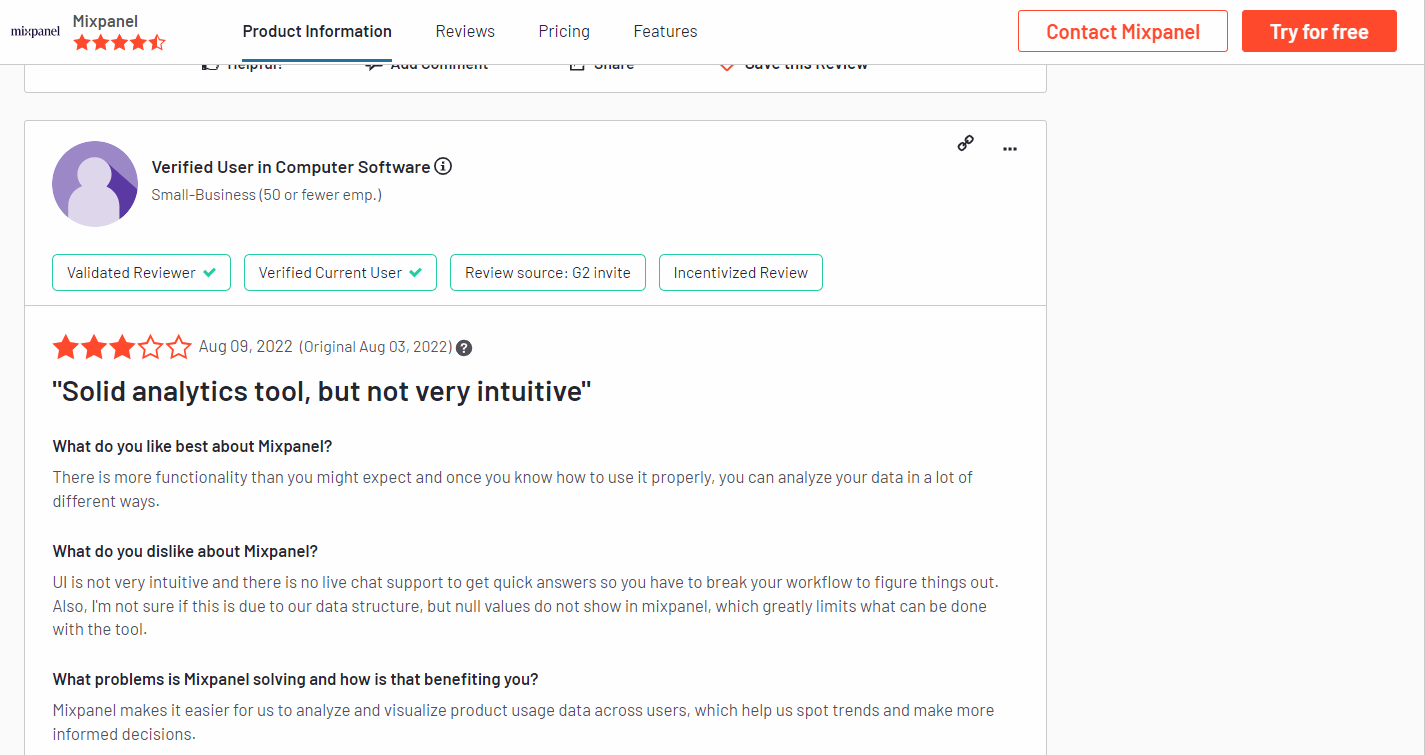
Mixpanel’s pricing
Mixpanel’s pricing plan is divided into 3 plans; the starter plan, the enterprise plan, and the growth plan.
Here’s an overview of the pricing plans and features of each plan:
- Starter plan: This plan features essentials to find product-market fit. It is free and allows up to 20M monthly events. In addition, you get access to all core reports for user journey analysis, templates to get started easily, unlimited integrations, and unlimited collaborators.
- Growth plan: This plan costs $20 per month for up to 100M monthly events. You get all features in the starter plan plus unlimited saved reports to monitor, update & iterate on KPIs, Mixpanel modeling layer, and group analytics & data pipeline add-ons.
- Enterprise plan: This plan empowers your team, especially if you have a large organization. You’ll have to contact their sales representatives for the cost. This plan features all the benefits of the growth plan plus advanced access controls, shared data views for collaboration, automated provisioning & SSO, and prioritized support.

3 Reasons why you might need a Mixpanel alternative
Let’s look at the most common scenarios where Mixpanel is NOT the right tool for your user onboarding needs and you should be looking into using a different one:
- You need better customer support: Mixpanel has been criticized for its poor customer service. You can have a hard time getting the software problems fixed quickly since you might rarely get an instant response from the support team.
- You want behavior-driven product tours: you are seeking to guide users through their product’s features using behavior-driven triggers, a solution like Userpilot is more appropriate.
- You want advanced segmentation: You can create targeted user segments based on specific parameters such as pricing plans, company, location, required actions, NPS score, and more on Userpilot.
Userpilot – A better alternative for product analytics
 Product analytics lets you collect and analyze data about how users interact with your product so you can extract actionable insights. Userpilot lets you look at granular product analytics, such as which features have the highest adoption rates, and big-picture insights like trend reports. Here are Userpilot’s top product analytics features:
Product analytics lets you collect and analyze data about how users interact with your product so you can extract actionable insights. Userpilot lets you look at granular product analytics, such as which features have the highest adoption rates, and big-picture insights like trend reports. Here are Userpilot’s top product analytics features:
- Feature tagging: Userpilot’s click-to-track feature tagger lets you view how many times a feature has been used and by how many users to measure its adoption. Users on the Starter plan can add up to 15 feature tags while those on the Growth or Enterprise tier can create unlimited tags.
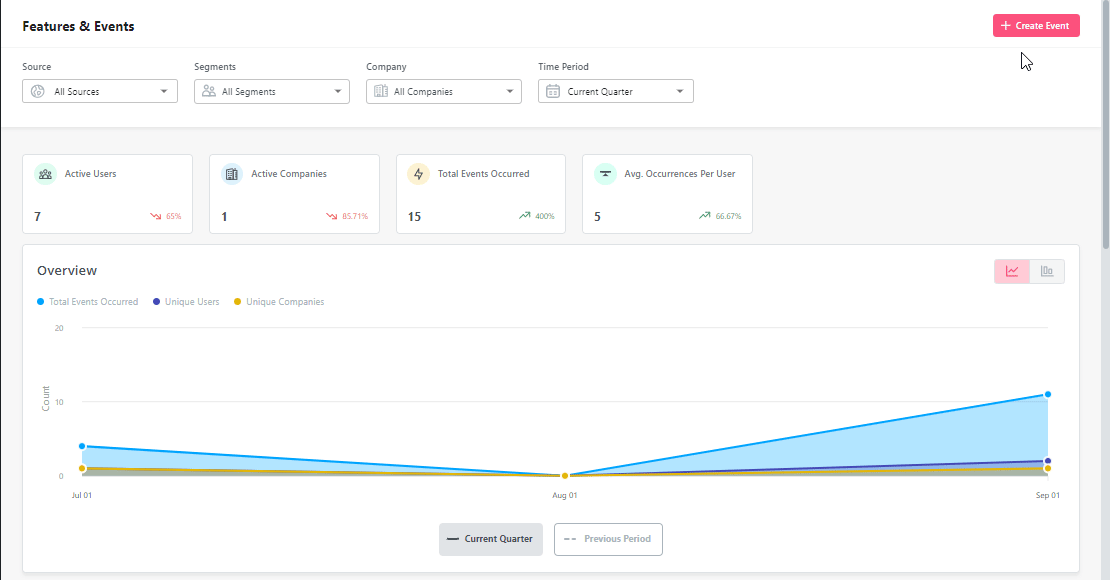
- Trends and funnels: Userpilot’s trends and funnels report lets you extract actionable insights from big data. You’ll be able to see which stage of an onboarding/conversion funnel most users drop out on and create trend reports with detailed breakdowns by user or time period.

- Retention tables: This lets you gauge product performance – how effective it is at retaining users using cohort tables and retention curves.
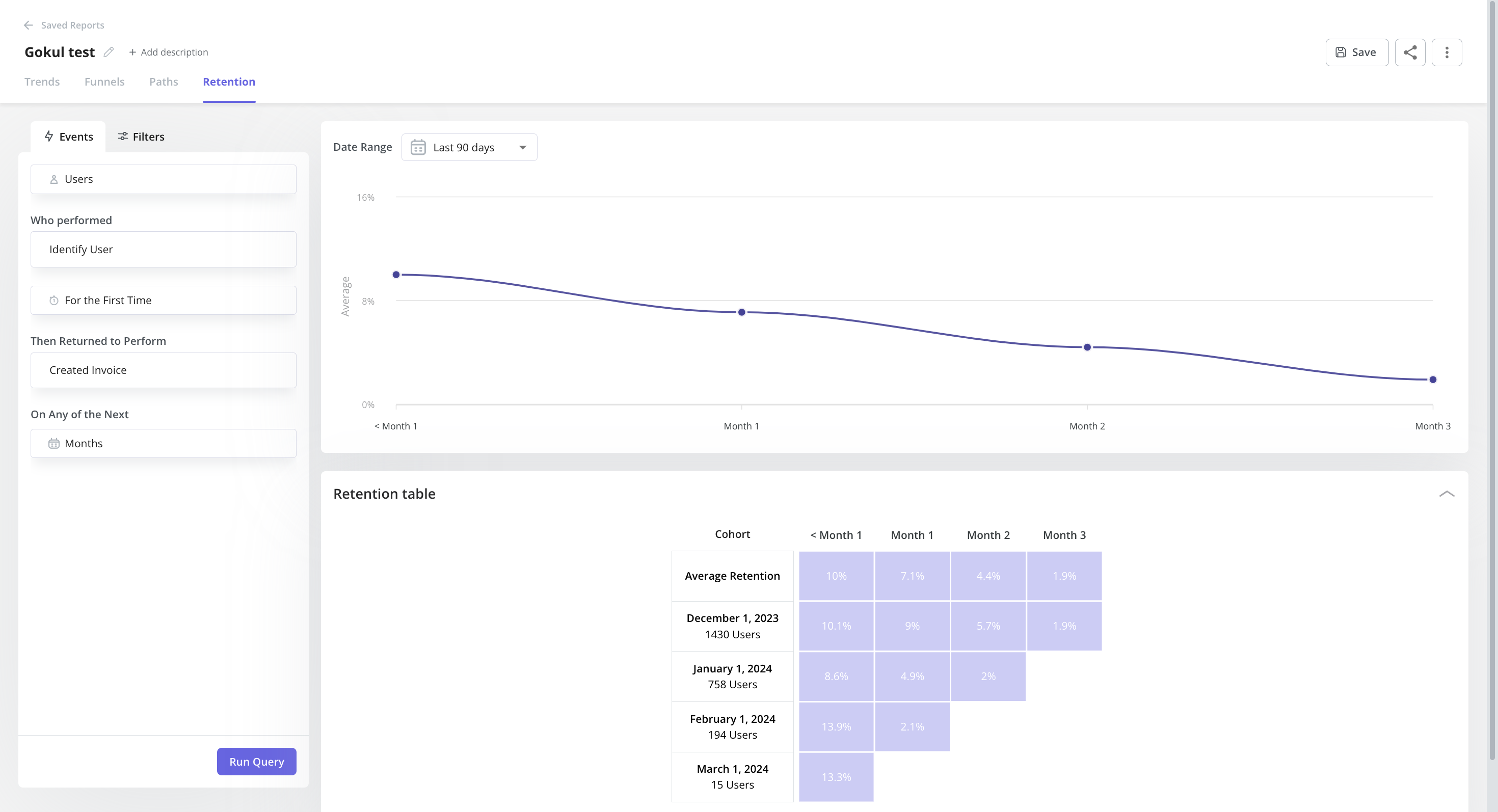
- Paths: You can generate and access path reports directly within the reporting builder in Userpilot, alongside funnels, trends, and retention reports. With Paths, you can have an overview of how users navigate your product features – offering invaluable insights into their interactions with your products.

- Saved reports: The saved reports analytics dashboard shows you all the reports you’ve created and lets you filter, export, or delete any reports in a single click. In addition to adding filters or sorting by report type, you can also edit or duplicate reports to help you review analytics.

- Analytics dashboards (Product Usage, New Users Activation, Core Feature Engagement, User Retention): These dashboards enable you to keep track of your key product performance and user behaviour metrics at a glance, without any technical setup required.

- Analytics integrations: Userpilot integrates with some of the most popular analytics tools like Amplitude, Mixpanel, Segment, Google Analytics, and more. This makes it possible to sync product analytics both ways between the tools in your tech stack (two-way integration is only available for Hubspot at the time of writing, more to come).

Userpilot’s feature tags
Tracking feature adoption is essential to identify under-utilized features and push users toward discovering them. Userpilot lets you tag features without writing any code, track adoption through engagement analytics, and visualize feature usage with heatmaps.
Here’s how you can use Userpilot to conduct feature audits and drive feature adoption:
- No-code tagging: Userpilot’s no-code feature tagger lets you add tags through the Chrome extension’s visual builder. You’ll also be able to select whether the tag should track clicks, hovers, or text inputs from users to get contextual data that reflects actual feature usage.
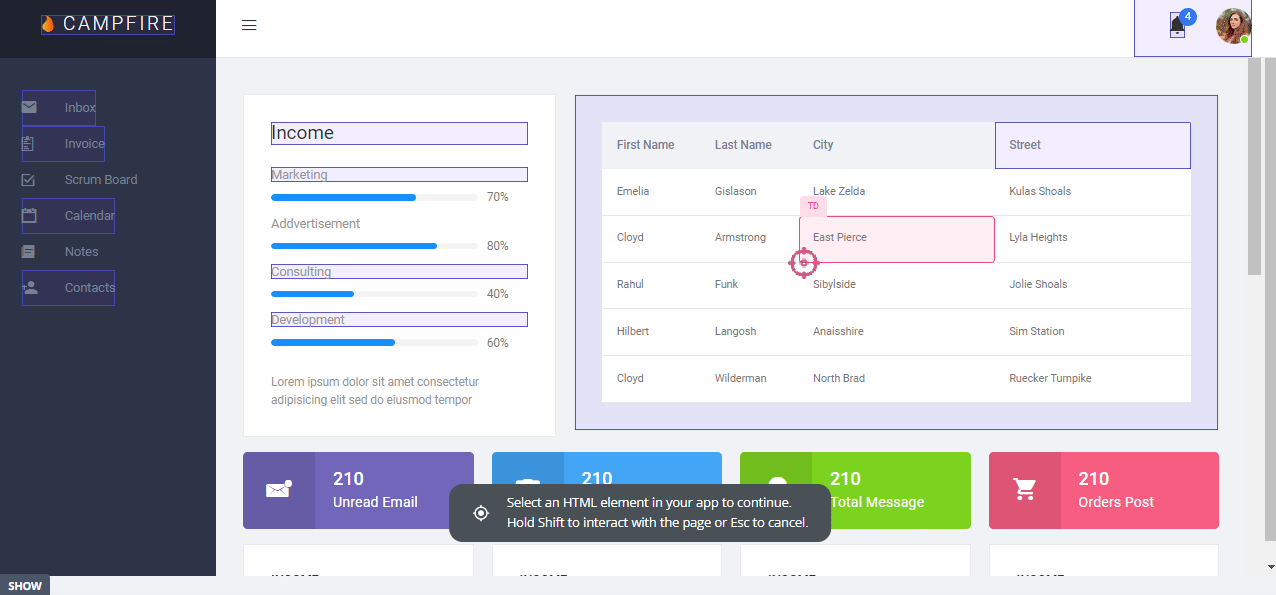
- Feature tags: The advanced feature analytics of Userpilot lets you track feature performance trends, see the top 20 features across your user base, and see granular data for individual features. You’ll also be able to filter your data by segment, company, or time period.
- Usage heatmaps: Userpilot heatmaps show you the features/elements with the most interactions. Heatmaps can be generated on the Features & Events dashboard by clicking on a tagged feature, editing it in the builder, and then clicking the heatmap icon on the bottom toolbar.
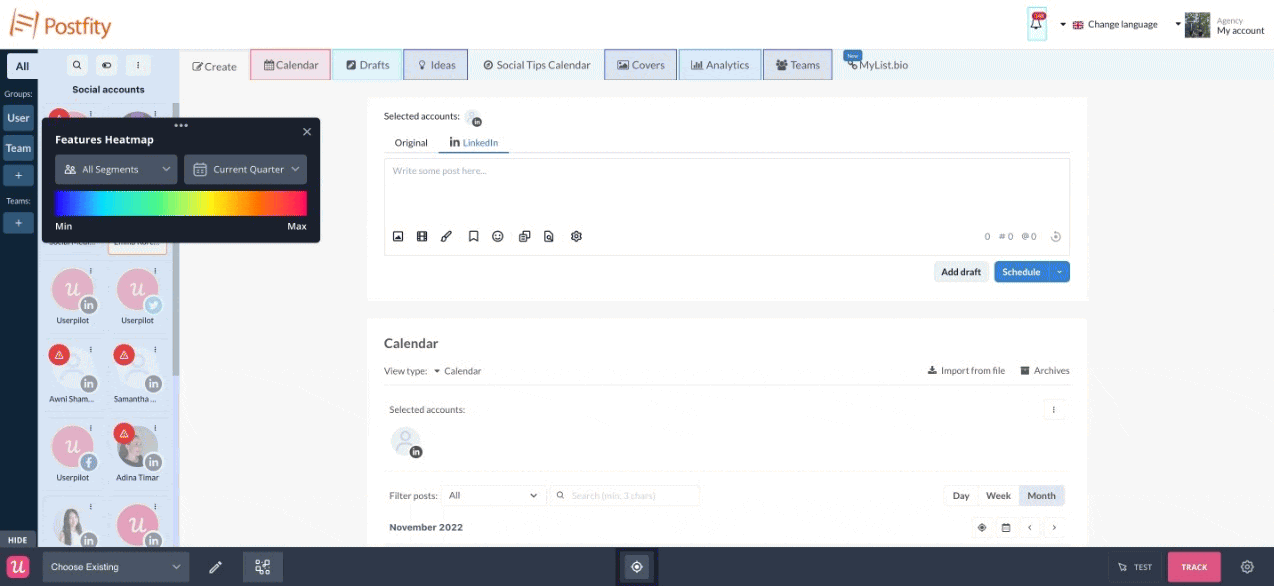
Userpilot’s funnels
Tracking user funnels is essential to getting a deeper understanding of the customer journey and reducing friction points. Userpilot helps you track user funnels by creating funnel reports, reviewing saved reports in bulk, and seeing key metrics like the average time it takes to complete a funnel.
Here’s how you can use Userpilot to generate funnel charts:
- Funnels: Userpilot’s funnel reports can show you the percentage of users that progress from one stage to another. Stages could consist of pages, actions, or other activation points. You can also set a specific order that these steps need to be completed or adjust the time period.

- Reports: The saved reports area of your Userpilot account lets you view, edit, duplicate, delete, or export (as a CSV file) all the analytics reports that you (or your teammates) have generated. You can also filter results by the teammate who created the report or the type of report.
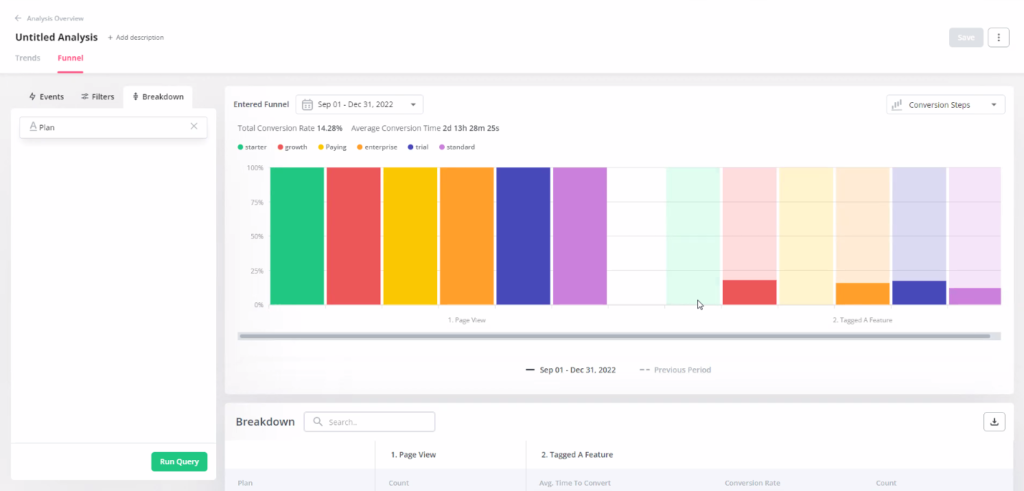
- Duration: The granular funnel analytics can offer more insights into each stage of a particular user funnel, such as how long it took the majority of your users to complete it from start to finish. You can filter by time period and set minimum/maximum parameters to remove outliers.

Userpilot’s paths
Path reports are essential for understanding user flows and journeys, offering invaluable insights into their interactions with our platform or application.
Within the Paths chart(s) visualization in Userpilot, you can:
- See the different flows/links users take from one step/event to another.
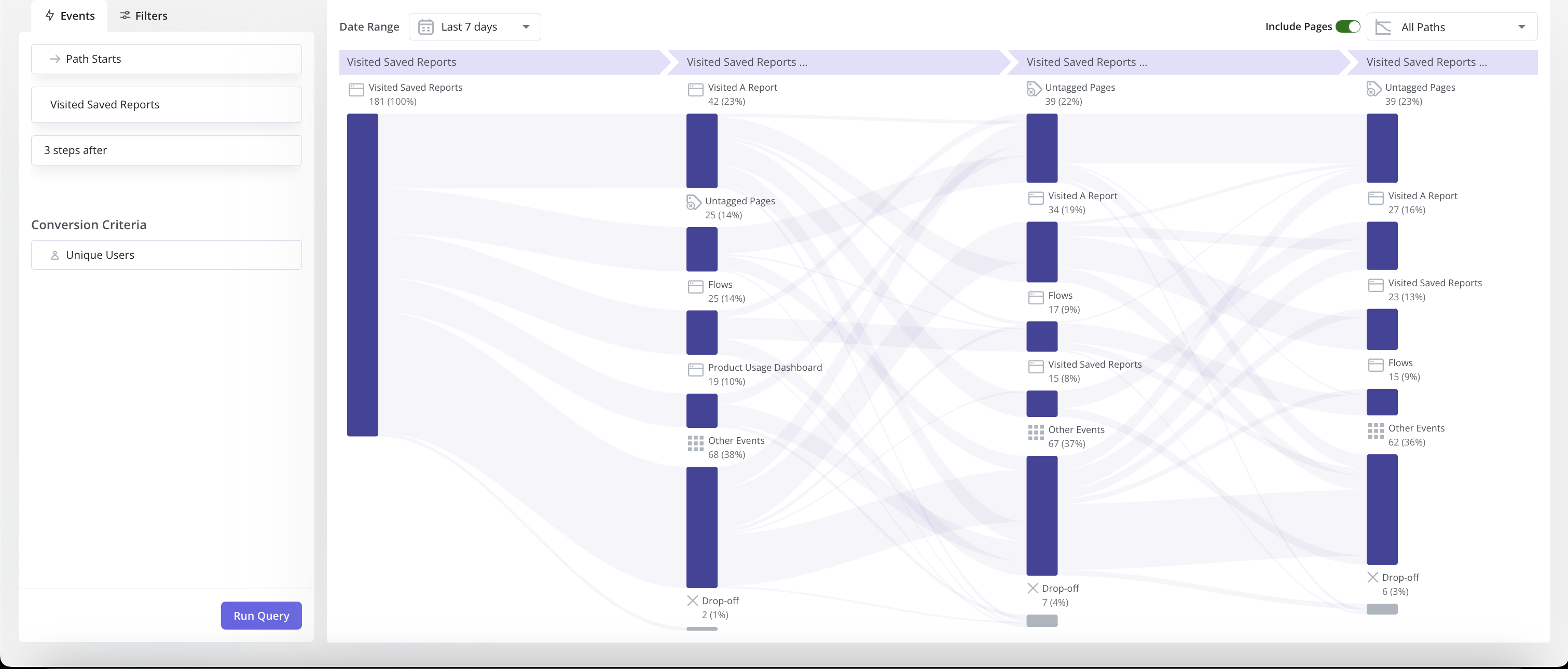
- Choose how many steps after or before the starting/ending event you want to report Users’ flows for.
- Choose whether you want to include Pages (i.e. Both User-Tagged and Untagged) in the visualization.
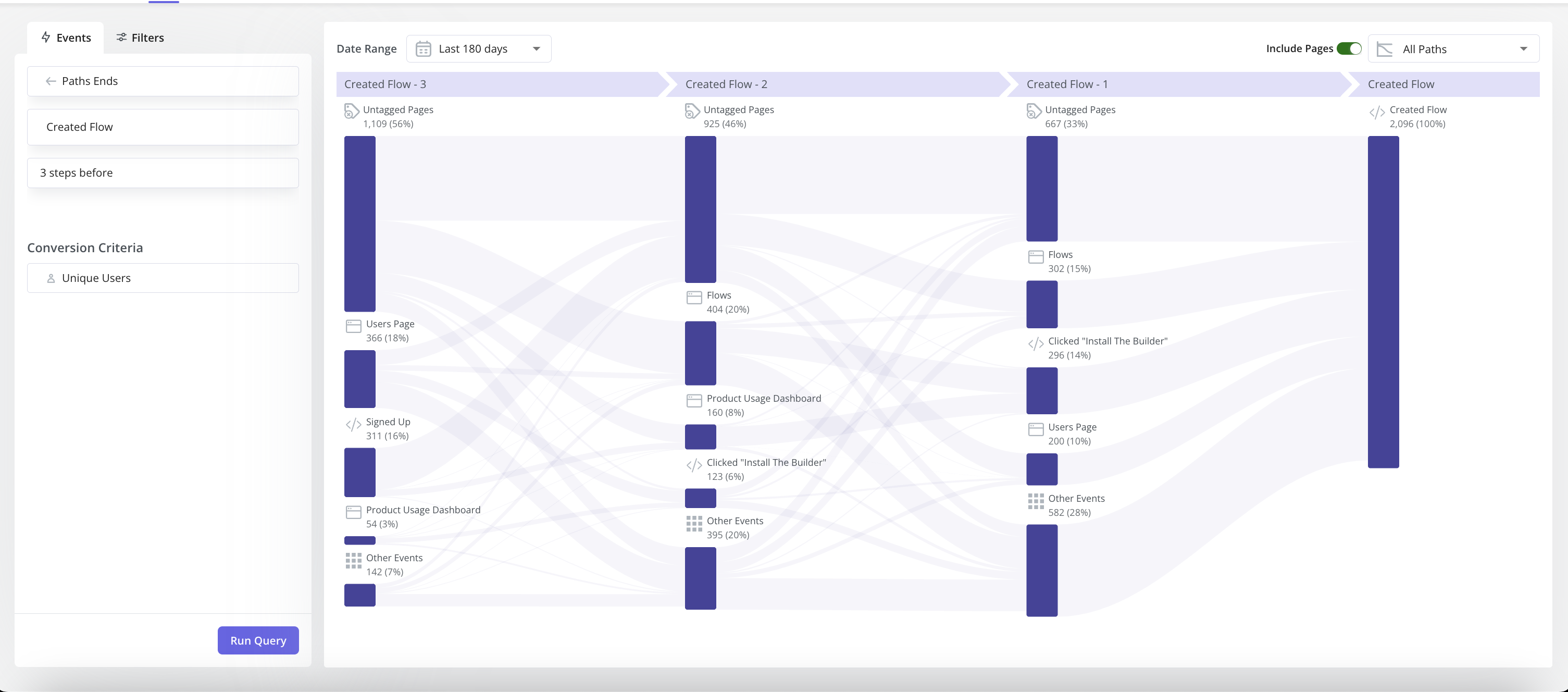
- Change the period of the analysis.
- Change the way you want to view the analysis: All Paths vs. Top Path (i.e. most common).

- Narrow down the targeted end-users by applying global or inline (event-specific) filters.
- View a breakdown of the end-users (or their associated companies) upon clicking on a specific node/step in the visualization chart.
You also have automatic path analysis in Userpilot’s core feature engagement analytics dashboards without having to set up anything. This will give you an overview of user navigation and engagement with your product so you have insights to work on improving their experience. 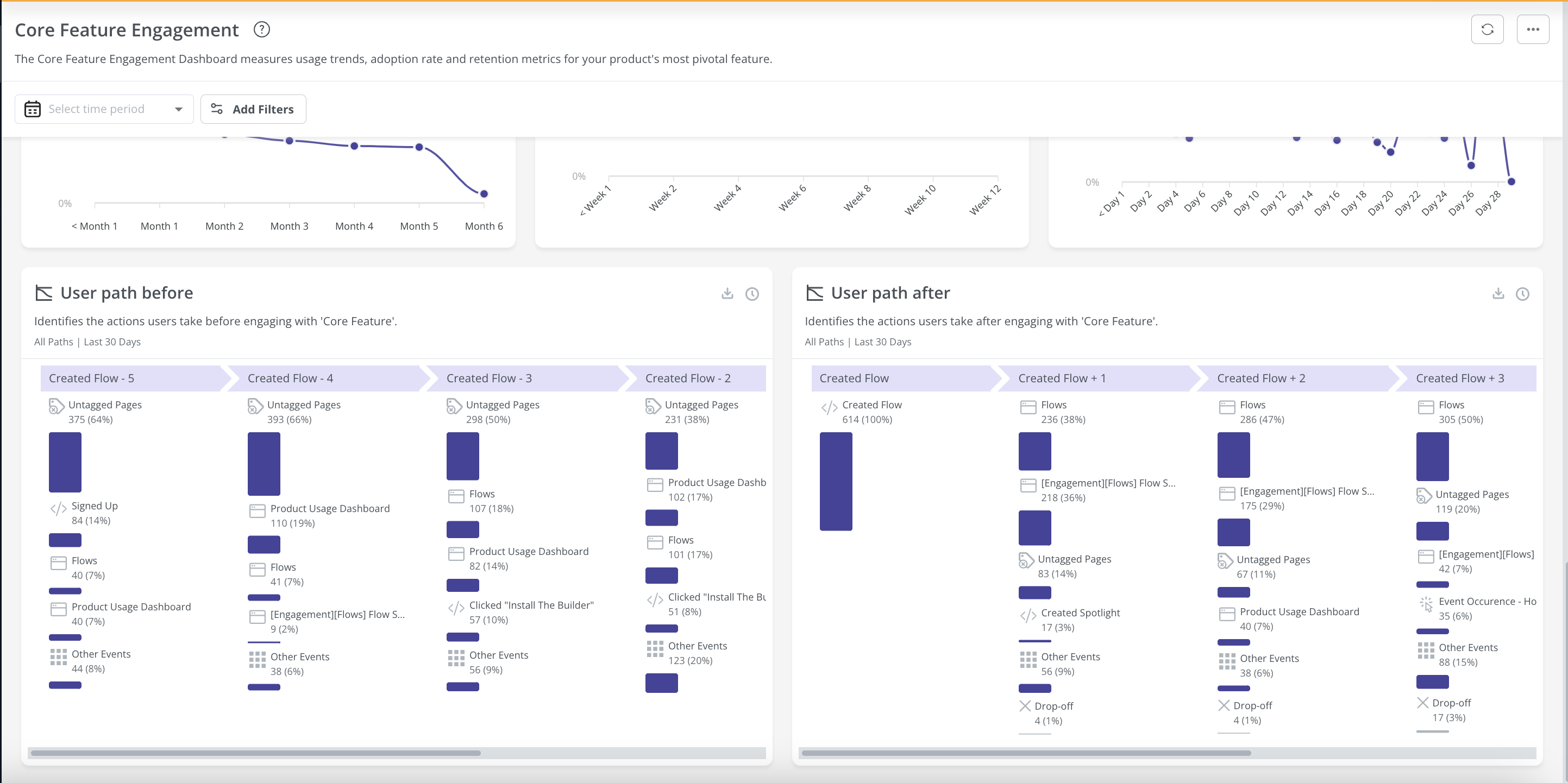
Userpilot’s in-app events
Tracking and analyzing event data gives you a better understanding of user behavior so you can capitalize on opportunities to improve the in-app experience.
Here are the ways you can use Userpilot as an event-tracking tool:
- Event tracking: The Userpilot flow builder lets you track custom events by tagging individual features (Feature Tag), by API (called Tracked Events) or by setting them up using a combination of feature tags and tracked events (Custom Events).

- Feature tags: Userpilot’s no-code feature tagger lets you track important features/elements based on different interaction types (clicks, hovers, and text inputs). You can then display the engagement and performance of different features through heatmaps.

- Data integrations: Userpilot has native integrations with popular analytics tools like Amplitude, Mixpanel, Google Analytics, and more. This makes it possible to sync your event data across multiple tools within your tech stack.

What are the pros and cons of Userpilot?
Userpilot pros
As a full-suite digital adoption platform, Userpilot has all the features you need to onboard users, track analytics, and gather feedback from customers without writing a single line of code. Here are a few pros of using Userpilot as your product growth solution:
- No-code builder: Userpilot’s Chrome extension lets you build flows, add UI elements, and tag features without writing a single line of code.
- UI patterns: There are plenty of UI patterns to choose from when using Userpilot, such as hotspots, tooltips, banners, slideouts, modals, and more!
- Startup-friendly: Userpilot’s entry-level plan gives you access to all available UI patterns so you can hit the ground running.
- Walkthroughs and flows: Build engaging interactive walkthroughs and personalized onboarding flows that target specific segments of your user base.
- Self-service support: Build an in-app resource center to help users solve problems, customize its appearance to align it with your brand, and insert various types of content (videos, flows, or chatbots) to keep your customers satisfied.
- A/B testing: Userpilot’s built-in A/B testing capabilities will help you split-test flows, iterate on the best-performing variants, and continually optimize based on user behavior.
- Feedback collection: Userpilot has built-in NPS surveys with its own unified analytics dashboard and response tagging to help you retarget users. There are other survey types to choose from and you can even create your own custom survey.
- Survey templates: There are 14 survey templates to choose from so you can gather feedback on specific features or run customer satisfaction benchmarking surveys like CSAT and CES.
- Advanced analytics: Userpilot lets you analyze product usage data, monitor engagement on all in-app flows, and use the data to create user segments that are based on behaviors instead of demographics.
- Event tracking: Userpilot’s no-code event tracking lets you tag UI interactions (hovers, clicks, or form fills) and group them into a custom event that reflects feature usage.
- Third-party integrations: Userpilot has built-in integrations with tools like Amplitude, Mixpanel, Kissmetrics, Segment, Heap, HubSpot, Intercom, Google Analytics, and Google Tag Manager so you can share data between all the solutions in your tech stack.
Userpilot’s cons
Of course, no tool is perfect and there are a few cons to consider before choosing Userpilot as your user onboarding or product growth solution:
- Employee onboarding: Currently, Userpilot only supports in-app customer onboarding.
- Mobile apps: Userpilot doesn’t have any mobile compatibility which could make it difficult for developers with cross-platform applications to create a consistent user experience for both versions of their product.
- Freemium plan: There’s no freemium Userpilot plan so those bootstrapping their startup and need sub-$100 solutions should consider more affordable onboarding platforms like UserGuiding or Product Fruits.
What do users say about Userpilot?
Most users laud Userpilot for its versatile feature set, ease of use, and responsive support team:
I recently had the pleasure of using Userpilot, and I must say it exceeded all my expectations. As a product manager, I’m always on the lookout for tools that can enhance user onboarding and improve overall user experience. Userpilot not only delivered on these fronts but also went above and beyond with its impressive new features, unparalleled ease of use, and truly exceptional customer support.
What truly sets Userpilot apart is its outstanding customer support. Throughout my journey with Userpilot, the support team has been responsive, knowledgeable, and genuinely dedicated to helping me succeed. Whenever I had a question or encountered an issue, their support team was always there to assist promptly, going above and beyond to ensure my concerns were addressed effectively.

Source: G2.
Of course, other users are also kind enough to share constructive criticism regarding specific features like event tracking filters:
“The filtration while analyzing specific events is a little confusing. Understanding of custom properties and data management configuration could have been more organised.”

Source: G2.
Userpilot’s pricing
Userpilot’s transparent pricing ranges from $249/month on the entry-level end to an Enterprise tier for larger companies.
Furthermore, Userpilot’s entry-level plan includes access to all UI patterns and should include everything that most mid-market SaaS businesses need to get started.

Userpilot has three paid plans to choose from:
- Starter: The entry-level Starter plan starts at $249/month and includes features like segmentation, product analytics, reporting, user engagement, user feedback, and customization.
- Growth: The Growth plan starts at $499/month and includes features like resource centers, advanced event-based triggers, unlimited feature tagging, AI-powered content localization, EU hosting options, and a dedicated customer success manager.
- Enterprise: The Enterprise plan uses custom pricing and includes all the features from Starter + Growth plus custom roles/permissions, access to premium integrations, priority support, custom contract, SLA, SAML SSO, activity logs, security audit and compliance (SOC 2/GDPR).
Conclusion
There you have it.
It should be easier now to make an informed decision whether Mixpanel is your go-to option for Product analytics. Ultimately, the best choice will depend on your product and current needs.
If you’re looking for a better alternative to Mixpanel for Product analytics, book a Userpilot demo today to experience firsthand how it can enhance your user experience and drive product growth!


